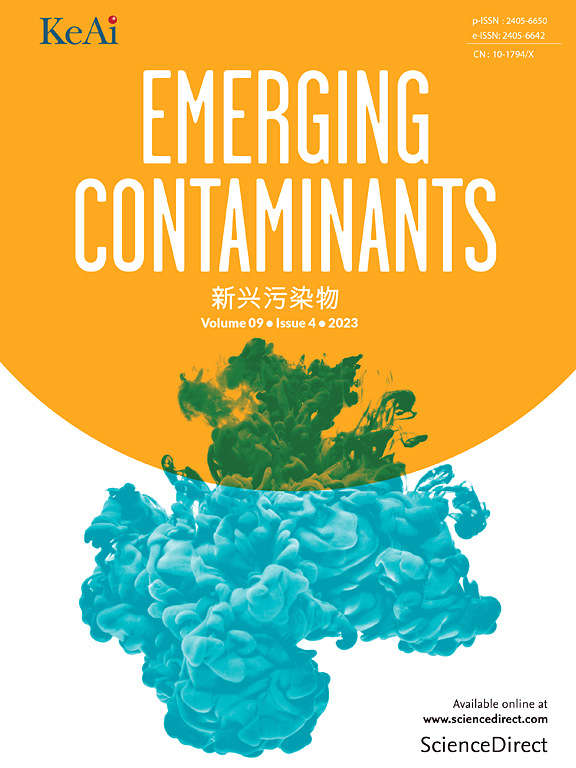The effect of tire microplastics on aerobic granular sludge performance
IF 6.9
2区 环境科学与生态学
Q1 ENVIRONMENTAL SCIENCES
引用次数: 0
Abstract
Although tire microplastics (TMPs) constitute a substantial portion of microplastic entering wastewater treatment plants, there is a knowledge gap regarding the influence of TMPs on aerobic granular sludge (AGS) systems, which, being more resilient than activated sludge, are becoming increasingly important in modern wastewater treatment. This study investigated the effect of TMPs in wastewater (50, 100, 250, and 500 mg/L) on AGS performance and microbiome. TMPs did not affect organics and phosphorus removal, however, total nitrogen removal was significantly higher (about 9 %) at 500 mg TMPs/L compared to the control. TMPs improved biomass settling, but this was due to TMP accumulation (TMPs comprised over 50 % of biomass at 500 mg TMP/L) rather than improved granulation. The biomass yield coefficient was five times lower at 500 mg TMP/L than in the control. TMPs elevated dehydrogenase activity (free radical generation) and increased the abundance of microbes involved in polyP synthesis and nitrogen metabolism. TMP presence increased the microbiome potential in terms of antibiotic resistance genes (cmd and marR) and the abundance of hydrolases, which degrade rubber-associated ester bonds, and significantly increased the abundance of MP-degraders belonging to genera Ideonella, Rhodobacter, Xanthobacter, and Hydrogenophaga. This study demonstrates that while TMPs in wastewater do not impair nutrient removal by AGS, their accumulation significantly degrades biomass properties, complicating sludge management and disposal. Furthermore, TMPs alter the AGS microbiome's composition and metabolic potential. These findings highlight the importance of integrating AGS systems into urban wastewater treatment, optimizing sludge management strategies, and developing targeted approaches to address the challenges posed by TMPs.

轮胎微塑料对好氧颗粒污泥性能的影响
尽管轮胎微塑料(TMPs)构成了进入污水处理厂的微塑料的很大一部分,但关于TMPs对好氧颗粒污泥(AGS)系统的影响,人们还存在知识缺口,而好氧颗粒污泥(AGS)系统比活性污泥更具弹性,在现代废水处理中越来越重要。本研究考察了50、100、250和500 mg/L废水中TMPs对AGS性能和微生物组的影响。在500 mg TMPs/L时,总氮去除率显著高于对照组(约9%)。TMPs改善了生物质沉降,但这是由于TMP积累(在500mg TMP/L时,TMPs占生物量的50%以上),而不是改善了造粒。500mg TMP/L处理的生物量产量系数比对照降低了5倍。TMPs提高脱氢酶活性(自由基生成),增加参与polyP合成和氮代谢的微生物丰度。TMP的存在增加了微生物组的抗生素抗性基因(cmd和marR)和水解酶的丰度,水解酶可降解橡胶相关的酯键,并显著增加了Ideonella属、Rhodobacter属、Xanthobacter属和Hydrogenophaga属的mp降解物的丰度。该研究表明,虽然废水中的TMPs不会影响AGS对营养物质的去除,但它们的积累会显著降低生物质特性,使污泥管理和处置复杂化。此外,TMPs改变了AGS微生物组的组成和代谢潜力。这些发现强调了将AGS系统整合到城市污水处理中、优化污泥管理策略以及制定有针对性的方法来应对TMPs带来的挑战的重要性。
本文章由计算机程序翻译,如有差异,请以英文原文为准。
求助全文
约1分钟内获得全文
求助全文
来源期刊

Emerging Contaminants
Medicine-Public Health, Environmental and Occupational Health
CiteScore
10.00
自引率
6.70%
发文量
35
审稿时长
44 days
期刊介绍:
Emerging Contaminants is an outlet for world-leading research addressing problems associated with environmental contamination caused by emerging contaminants and their solutions. Emerging contaminants are defined as chemicals that are not currently (or have been only recently) regulated and about which there exist concerns regarding their impact on human or ecological health. Examples of emerging contaminants include disinfection by-products, pharmaceutical and personal care products, persistent organic chemicals, and mercury etc. as well as their degradation products. We encourage papers addressing science that facilitates greater understanding of the nature, extent, and impacts of the presence of emerging contaminants in the environment; technology that exploits original principles to reduce and control their environmental presence; as well as the development, implementation and efficacy of national and international policies to protect human health and the environment from emerging contaminants.
 求助内容:
求助内容: 应助结果提醒方式:
应助结果提醒方式:


